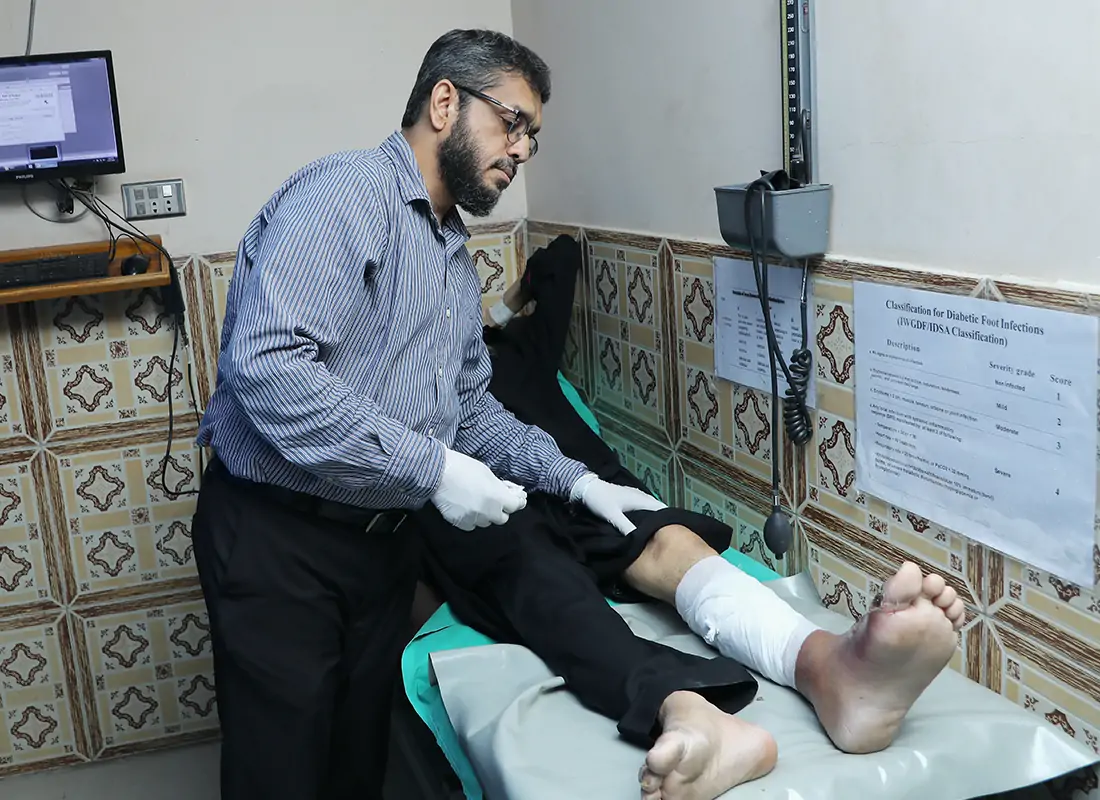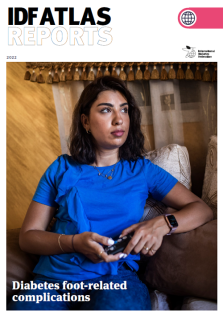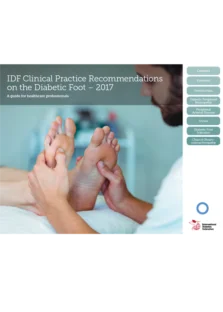Nerve disease, also known as diabetes-related neuropathy, can affect approximately 1 in 2 people living with diabetes. It is caused by high blood glucose levels and high blood pressure.
Neuropathy primarily affects the nerves and can severely affect various bodily functions. The most common and significant impact is on the lower limbs, particularly the feet. People with diabetes are at higher risk of foot ulcers and lower limb amputations due to neuropathy. Globally, diabetes-related foot complications are the third most common diabetes complications after heart disease and chronic kidney disease.
Nerve disease can also affect the digestive system, leading to complications in the digestion and absorption of nutrients, and cause sexual dysfunction in both men and women.
Good diabetes management and regular check-ups can reduce the risk of nerve-related complications.

Know the main signs and symptoms of nerve disease:
- Persistent pain, numbness or tingling in the feet or hands.
- Muscle weakness.
- Paresthesia, (tingling, prickling, numbness) of the skin with no obvious physical cause.
- Digestive issues.
- Bladder issues
If you experience any of these signs and symptoms, consult a healthcare professional for further evaluation and guidance.
Signs and symptoms of nerve disease can vary depending on the type of neuropathy and the affected nerves. Knowing what to look for is important for early intervention that can significantly improve outcomes and prevent serious complications.
Understanding nerve disease
There are four main types of diabetic neuropathy that can affect people with diabetes:
Peripheral neuropathy commonly affects the feet and legs but can also impact the arms and hands. The main cause is prolonged high glucose levels that can damage the nerves. Other causes are metabolic factors, such as abnormal cholesterol levels and high blood pressure, and neurovascular factors, such as damage to the blood vessels that carry oxygen and nutrients to the nerves.
Autonomic neuropathy affects the autonomic nervous system that controls involuntary body functions. The causes are linked to damage in the nerves regulating internal processes. These internal processes include heart rate, digestion and bladder control.
Proximal neuropathy, also known as diabetic amyotrophy, leads to severe pain in the thighs, hips or buttocks, often resulting in weakness in the legs. The condition can significantly impact mobility and quality of life. For people with diabetes, the causes of proximal neuropathy are linked to high glucose levels.
Focal neuropathy, or mononeuropathy, causes sudden weakness or pain in specific nerves, often in the head, torso or leg. Over time, high levels of glucose and lipids, such as triglycerides, caused by diabetes can damage the nerves and small blood vessels that nourish the nerves, leading to focal neuropathies. The condition occurs when nerves are compressed or trapped in narrow passages between bones and tissues. When focal neuropathy involves trapped nerves, it is known as entrapment. People with diabetes are more likely to experience entrapments than people without diabetes.
People with diabetes need to check their feet regularly for cuts and blisters because diabetes can lead to nerve damage and poor circulation, particularly in the feet.
Managing the risks
Preventing and managing nerve disease requires a proactive approach. In addition to regular foot examinations, adopting healthy lifestyle habits can help delay or prevent nerve disease. These include maintaining a balanced diet and engaging in regular physical activity to help manage glucose levels.
In people with diabetes, minor injuries like cuts and blisters can develop into serious infections if left untreated. It is therefore important to check the feet regularly to help identify potential complications early and reduce the risk of foot ulcers or amputation. Additionally, keeping feet clean and moisturised, trimming toenails carefully, and wearing comfortable, well-fitting footwear can help prevent foot complications.
Behavioural risk factors
Certain behavioural risk factors such as smoking and alcohol consumption can exacerbate the progression of nerve disease. Smoking can impair blood circulation, further restricting the already compromised blood flow to the extremities, while excessive alcohol consumption and poor stress management can also worsen symptoms. Knowing these risks and making the necessary lifestyle adjustments can limit the progression of nerve disease and improve overall physical and mental well-being.
Multi-sectoral approach
Addressing and reducing the impact of nerve disease requires a collaborative effort, involving the expertise of healthcare professionals, the guidance of diabetes educators, and the active participation of people with diabetes and their cares. This multi-sectoral approach allows for comprehensive care that addresses the medical, dietary, and lifestyle aspects of managing nerve disease. Each role is crucial, and together, can help effectively navigate the challenges of this condition.
Take control of your nerve health
By integrating proactive measures into their daily routine, people with diabetes can help protect their nerve health and reduce the risk of complications. Regular check-ups, adhering to prescribed medications, and adopting healthy lifestyle habits are essential to reducing the risks and maintaining overall physical and mental well-being.
Related resources

Diabetes-related foot complications

IDF Clinical Practice Recommendations on the Diabetic Foot 2017

